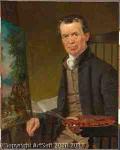Edward Hicks
Edward Hicks
Place: Attleboro
Born: 1780
Death: 1849
Biography:
Edward Hicks was an American folk painter and distinguished religious minister of the Society of Friends, born on April 4, 1780, in Attleboro (now Langhorne), Bucks County, Pennsylvania. He became a Quaker icon due to his paintings, which reflected his strong faith and values.
Early Life and Career
Hicks' parents were Anglican, but he was raised by a close family friend, Matron Elizabeth Twining, who introduced him to the Quaker beliefs. At the age of thirteen, Hicks began an apprenticeship with coach makers William and Henry Tomlinson, where he learned the craft of coach painting. In 1800, he left the Tomlinson firm to work independently as a house and coach painter.
Quaker Ministry and Painting Career
In 1803, Hicks was accepted for membership in the Society of Friends and started attending Quaker meetings regularly. He married a Quaker woman, Sarah Worstall, and began traveling throughout Philadelphia as a Quaker preacher. To support his growing family, Hicks expanded his trade to painting household objects and farm equipment, as well as tavern signs. His financial difficulties led him to briefly give up ornamental painting in 1815, but he resumed it in 1816. Key aspects of Edward Hicks' life and career:
- Edward Hicks was a self-taught artist who became known for his folk paintings.
- He was a minister of the Society of Friends, also known as Quakers.
- Hicks' paintings often depicted scenes from nature and reflected his strong faith and values.
- His most famous series of paintings is Peaceable Kingdom, which represents harmony and coexistence between humans and animals.
Artistic Style and Legacy
Hicks' work was influenced by the Quaker belief in the Inner Light, which emphasizes the importance of personal spiritual experience. His paintings often featured simple and naïve compositions, with a focus on nature and animal life. The Peaceable Kingdom series, which includes 62 versions, is a prime example of Hicks' unique style. Some notable paintings by Edward Hicks include:
- Peaceable Kingdom (31), housed at the Yale University Art Gallery.
- Falls of Niagara, housed at the Abby Aldrich Rockefeller Folk Art Center.
- George Washington with His Army Crossing the Delaware, also housed at the Abby Aldrich Rockefeller Folk Art Center.
Conclusion
Edward Hicks' life and career serve as a testament to the power of faith and art. His unique style, which blended folk painting with Quaker values, has left a lasting legacy in the world of American art. To learn more about Edward Hicks and his work, visit Wikioo.org, where you can find a wide selection of his paintings, including Peaceable Kingdom and Falls of Niagara.
Wikipedia link: Click Here














